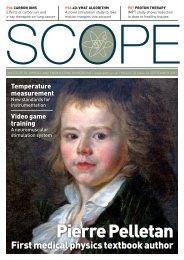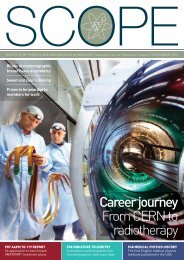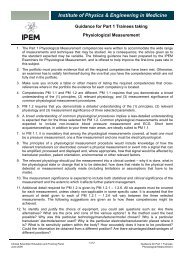Spotlight 3: Optical Techniques in Medical Imaging - Institute of ...
Spotlight 3: Optical Techniques in Medical Imaging - Institute of ...
Spotlight 3: Optical Techniques in Medical Imaging - Institute of ...
Create successful ePaper yourself
Turn your PDF publications into a flip-book with our unique Google optimized e-Paper software.
I n s t i t u t e o f P h y s i c s a n d E n g i n e e r i n g i n M e d i c i n eS p o t l i g h t o n<strong>Optical</strong> <strong>Techniques</strong> <strong>in</strong> <strong>Medical</strong> Imag<strong>in</strong>g03Perspectives on:physics and eng<strong>in</strong>eer<strong>in</strong>g <strong>in</strong> medic<strong>in</strong>e and biology<strong>Institute</strong> <strong>of</strong> Physicsand Eng<strong>in</strong>eer<strong>in</strong>g <strong>in</strong> Medic<strong>in</strong>e
<strong>Optical</strong> imag<strong>in</strong>g techniques allowdoctors to see more clearlyEarly detection <strong>of</strong>breast cancer has been<strong>in</strong>strumental <strong>in</strong> reduc<strong>in</strong>gthe number <strong>of</strong> deathsfrom the disease. <strong>Optical</strong>mammography - whichreveals tumours by detect<strong>in</strong>gthe <strong>in</strong>creased blood supplythey need <strong>in</strong> order to grow- used <strong>in</strong> conjunction withthe exist<strong>in</strong>g X-ray screen<strong>in</strong>gprogramme would improvethe accuracy <strong>of</strong> diagnosisfor pre-menopausal womenby provid<strong>in</strong>g better imagecontrast, and allow morefrequent imag<strong>in</strong>g for exist<strong>in</strong>gpatients. In the opticalmammogram shown here(uppermost image), thelarge yellow area on theleft reveals a tumour <strong>in</strong> onebreast <strong>of</strong> a patient, whichshows up as a white region<strong>in</strong> the MRI scan below. Withfurther development, opticalmammography could alsodeterm<strong>in</strong>e whether tumoursare cancerous or not.03Most <strong>of</strong> us will undergo some form <strong>of</strong>medical scan <strong>in</strong> our lifetimes, even if it isjust a dental X-ray. Of course much moresophisticated scann<strong>in</strong>g equipment such asultrasound and MRI is also commonplace <strong>in</strong>the UK, br<strong>in</strong>g<strong>in</strong>g many benefits to patients<strong>in</strong>clud<strong>in</strong>g early diagnosis <strong>of</strong> disease andaccurate monitor<strong>in</strong>g <strong>of</strong> treatments. Onthe negative side however, some <strong>of</strong> theseimag<strong>in</strong>g procedures expose the patientto unwanted radiation and so cannot beperformed repeatedly. In addition manytechniques require bulky, expensiveequipment that may not be available atevery hospital.To help combat these problems physicistshave been develop<strong>in</strong>g a range <strong>of</strong> newoptical imag<strong>in</strong>g techniques that only<strong>in</strong>volve expos<strong>in</strong>g the patient to light, and<strong>in</strong> some cases are portable enough to beused by a bedside. These <strong>in</strong>clude <strong>Optical</strong>Mammography systems for monitor<strong>in</strong>gthe effectiveness <strong>of</strong> treatments such aslumpectomy and regular screen<strong>in</strong>g for earlysigns <strong>of</strong> breast cancer, and Diffuse <strong>Optical</strong>Tomography and Photoacoustic Imag<strong>in</strong>gwhich are both designed to monitor bloodvolume, oxygenation and flow <strong>in</strong> tissue.As unusual patterns <strong>in</strong> blood oxygenationand flow reveal the early stages <strong>of</strong> disease<strong>in</strong> s<strong>of</strong>t tissues, as well as blockages <strong>in</strong>arteries, these techniques are likely to proveparticularly valuable for patients such asstroke victims and premature babies.Other emerg<strong>in</strong>g optical techniques <strong>in</strong>cludea Scann<strong>in</strong>g Laser Ophthalmoscope forimag<strong>in</strong>g damage and disease <strong>in</strong>side eyes,and <strong>Optical</strong> Coherence Tomography whichcan differentiate between cancerousand normal tissue for a range <strong>of</strong> cancers<strong>in</strong>clud<strong>in</strong>g sk<strong>in</strong> cancer, and can be used tomonitor microsurgery.Diffuse <strong>Optical</strong> TomographyIn diffuse optical tomography, an array<strong>of</strong> optical fibre sources is used to sh<strong>in</strong>e<strong>in</strong>frared light - with a range <strong>of</strong> wavelengthsjust beyond visible red light - <strong>in</strong>to whicheverregion <strong>of</strong> the body needs to be lookedat. Boundaries between different parts <strong>of</strong>organs, different tissue layers, cell walls,and sub-structures with<strong>in</strong> <strong>in</strong>dividual cells,<strong>Optical</strong> <strong>Techniques</strong> <strong>in</strong> <strong>Medical</strong> Imag<strong>in</strong>greflect and scatter (or ‘diffuse’) this light <strong>in</strong>all directions. Any light that happens to bescattered towards a correspond<strong>in</strong>g array<strong>of</strong> optical fibre detectors is recorded, andspecially designed image reconstructions<strong>of</strong>tware processes this data to produce a3D image <strong>of</strong> the area be<strong>in</strong>g studied.Particular wavelengths <strong>of</strong> <strong>in</strong>frared lightare absorbed by certa<strong>in</strong> tissues andsubstances. For example the absorption<strong>of</strong> haemoglob<strong>in</strong> (the prote<strong>in</strong> <strong>in</strong> blood thatcarries oxygen around the body) is differentwhen it is carry<strong>in</strong>g oxygen from when it isde-oyxgenated. So to determ<strong>in</strong>e detailsabout oxygen levels <strong>in</strong> the blood andtissues, and to discern different tissue types,light at various wavelengths is shone <strong>in</strong> turn<strong>in</strong>to a patient. A composite image is thenbuilt up that displays the absorption <strong>of</strong> eachwavelength as a different colour, show<strong>in</strong>gthe amount and location <strong>of</strong> the absorptionby the <strong>in</strong>tensity <strong>of</strong> a particular colour <strong>in</strong>a given region. An optical mammogramproduced <strong>in</strong> this way is shown on the left.Diffuse optical tomography opens up thepossibility <strong>of</strong> more effective treatments forpatients with head <strong>in</strong>juries or strokes - andpremature babies - as all <strong>of</strong> these patientsneed quick, accurate diagnoses <strong>of</strong> any bra<strong>in</strong>regions lack<strong>in</strong>g <strong>in</strong> oxygen. If spotted fastenough, additional oxygen can be suppliedto the starved area before the tissue dies.The pictures on the back page show anexperimental diffuse optical tomographysystem devised at University CollegeLondon for premature babies. A variation onthis set-up can be used <strong>in</strong> sports medic<strong>in</strong>eto monitor changes <strong>in</strong> muscle oxygenationdur<strong>in</strong>g exercise.Measur<strong>in</strong>g the amount <strong>of</strong> oxygen <strong>in</strong> bloodcan also help reveal the presence <strong>of</strong>cancerous tumours, as rapidly grow<strong>in</strong>gtissue needs lots <strong>of</strong> oxygen and an<strong>in</strong>creased blood supply, and many largetumours have a dead region <strong>in</strong>side. Diffuseoptical tomography can generally ‘see’ 2-4centimetres <strong>in</strong>to the body, but this is deepenough to image the premature <strong>in</strong>fanthead or the grey matter on the surface <strong>of</strong>the adult bra<strong>in</strong>, and breasts up to 12cm<strong>in</strong> diameter can be fully imaged as breasttissue is relatively transparent.
Each <strong>of</strong> these images showsthe ret<strong>in</strong>a (<strong>in</strong>ner l<strong>in</strong><strong>in</strong>g <strong>of</strong> theeye conta<strong>in</strong><strong>in</strong>g the lightsensitivecells that allow usto see) <strong>of</strong> a patient with eyedisease. The large region<strong>in</strong> the centre <strong>of</strong> the imagesis the optic disc, which isthe start<strong>in</strong>g po<strong>in</strong>t for theoptic nerve. In the left-handimage, which was taken witha Scann<strong>in</strong>g LaserOphthalmoscope us<strong>in</strong>gthree different colouredlasers simultaneously, whitedeposits - caused by thetissue degenerat<strong>in</strong>g - canbe clearly seen with<strong>in</strong> theoptic disc. It is much harderto make these deposits out<strong>in</strong> the right-hand image,which was taken us<strong>in</strong>g aconventional fundus camera.Photoacoustic Imag<strong>in</strong>gEven more detailed images <strong>of</strong> bloodoxygenation levels can be provided byphotoacoustic imag<strong>in</strong>g. This <strong>in</strong>volves sh<strong>in</strong><strong>in</strong>ga very short pulse (a few tens <strong>of</strong> nanosecondslong) <strong>of</strong> <strong>in</strong>frared light <strong>in</strong>to a patient usuallyvia an optical fibre. Wherever this light isabsorbed, the energy from the light warmsthat region <strong>of</strong> blood or tissue up by abouta thousandth <strong>of</strong> a degree. This warm<strong>in</strong>gcauses the absorb<strong>in</strong>g region to expand bya t<strong>in</strong>y amount, and because this happensso quickly, a pressure wave is set up whichtravels through the tissue at the speed <strong>of</strong>sound before be<strong>in</strong>g picked up by a standardultrasound detector.The more a section <strong>of</strong> tissue or region <strong>of</strong>blood absorbs, the hotter it becomes andthe greater the ultrasound signal it creates.So unlike a standard ultrasound image,which shows the mechanical structure <strong>of</strong> thetissue, the photoacoustic image will revealthe different optical absorption properties <strong>of</strong>the tissue or blood. As with diffuse opticaltomography, different wavelengths <strong>of</strong> light areused to reveal vary<strong>in</strong>g levels <strong>of</strong> oxygenation <strong>in</strong>the blood as well as different tissue types.<strong>Optical</strong> Coherence TomographyThe optical equivalent <strong>of</strong> ultrasound isprovided by <strong>Optical</strong> Coherence Tomography(OCT). This uses a beam <strong>of</strong> <strong>in</strong>frared from alaser that is shone <strong>in</strong>to the body. Boundariesbetween the tissues reflect a small amountback, and this reflected signal is picked upand processed by an ultrafast detector. Tobuild up an image from the reflected signals,the laser beam (usually delivered by anoptical fibre) is moved around the region <strong>of</strong><strong>in</strong>terest - which can either be accessed fromoutside the body, or <strong>in</strong>ternally via a catheter.The resolution <strong>of</strong> OCT images is greaterthan ultrasound because the wavelengths<strong>of</strong> light are shorter, and so can be reflectedby smaller objects that would simply bewashed over by the longer wavelengths <strong>of</strong>sound waves. In fact with an ability to revealfeatures about a millionth <strong>of</strong> a metre <strong>in</strong> size,the images are so accurate that they couldremove the need for biopsy <strong>in</strong> many cases,and so provide a totally non-<strong>in</strong>vasivemethod <strong>of</strong> detect<strong>in</strong>g early signs <strong>of</strong> cancer.On the downside, OCT can only image2-3 millimetres <strong>in</strong>to tissue, but s<strong>in</strong>ce manycancers occur on the surface <strong>of</strong> organs, thisis not a severe limitation.Imag<strong>in</strong>g the eyeAs with the other optical imag<strong>in</strong>gtechniques, particular wavelengths <strong>of</strong> lightshow up certa<strong>in</strong> features <strong>in</strong> the eye well.Green light, for <strong>in</strong>stance, is particularlygood at imag<strong>in</strong>g microaneurysms, whichare bulges that form on weakened areas<strong>of</strong> the eyes’ blood vessels prior to thembreak<strong>in</strong>g. At present, the “fundus camera”- a photographic camera designed to imagethe ret<strong>in</strong>a at the back <strong>of</strong> the eye - is thema<strong>in</strong> <strong>in</strong>strument used to detect many signs<strong>of</strong> early eye disease. Unfortunately thisrequires a large amount <strong>of</strong> light to be shone<strong>in</strong>to the pupil to produce enough reflectedsignal to create an image. This not onlymeans eye drops are needed to dilate thepupil, but when several images need to betaken <strong>in</strong> close succession, it becomes veryuncomfortable for the patient. However,a Scann<strong>in</strong>g Laser Ophthalmoscope(SLO) currently under development atthe University <strong>of</strong> Aberdeen could removethese problems, and may even allow thediagnosis <strong>of</strong> a much wider range <strong>of</strong> eyediseases at an even earlier stage thancurrently possible.To obta<strong>in</strong> a full colour image, the AberdeenSLO sh<strong>in</strong>es three low-power lasers - onered, one blue and one green - <strong>in</strong> turn ata succession <strong>of</strong> po<strong>in</strong>ts at the back <strong>of</strong> theeye. The reflections from each spot areelectronically detected and comb<strong>in</strong>ed,enabl<strong>in</strong>g an image to be built up over a fewmilliseconds as the SLO scans the ret<strong>in</strong>a<strong>in</strong> the same sort <strong>of</strong> ‘raster’ pattern used tocreate TV pictures. As shown above, thisproduces clearer images than a funduscamera and because the scan is so fast,the eye - which is constantly <strong>in</strong> motion - haslittle time to move. Also, s<strong>in</strong>ce the eye isillum<strong>in</strong>ated by a narrow concentrated beam<strong>of</strong> light, the amount <strong>of</strong> light needed to createan image is very low and there is no needfor eye drops to dilate the pupil.By measur<strong>in</strong>g the amount <strong>of</strong> light <strong>of</strong> aparticular colour reflected from the ret<strong>in</strong>a,it may be possible <strong>in</strong> the future to analyseret<strong>in</strong>al tissue and see, for <strong>in</strong>stance, if itsblood flow is low. The SLO could also beused to image different types <strong>of</strong> blood cellsmov<strong>in</strong>g through the eye, by labell<strong>in</strong>g eachtype <strong>of</strong> cell with a fluorescent dye that onlyglows under light <strong>of</strong> a certa<strong>in</strong> colour. If thisenabled scientists to learn exactly how whiteblood cells react to <strong>in</strong>flammation <strong>in</strong> the eye,more effective treatments could be produced.
03I n s t i t u t e o f P h y s i c s a n d E n g i n e e r i n g i n M e d i c i n ePerspectives on:physics and eng<strong>in</strong>eer<strong>in</strong>g <strong>in</strong> medic<strong>in</strong>e and biologyAvailability <strong>in</strong> the UKWhilst prototype commercial opticalmammography systems built by Siemensand Philips are currently undergo<strong>in</strong>g test<strong>in</strong>g,the mammography and neo-natal imag<strong>in</strong>gfeatured here is still <strong>in</strong> the research stage,as is the SLO. Photoacoustic imag<strong>in</strong>g is <strong>in</strong>the early stages <strong>of</strong> trials but OCT is alreadyregularly used to diagnose ret<strong>in</strong>al disease,and is likely to become rout<strong>in</strong>e for almostevery area <strong>of</strong> medic<strong>in</strong>e with<strong>in</strong> the next fewyears. Various cl<strong>in</strong>ical trials are tak<strong>in</strong>g placeworldwide, and so far studies <strong>in</strong>dicate OCT iscapable <strong>of</strong> differentiat<strong>in</strong>g between cancerousand normal tissue <strong>in</strong> the gut and sk<strong>in</strong>.Although skilled physicists and eng<strong>in</strong>eers arerequired to operate prototype <strong>in</strong>struments,commercial tomography systems should bestraightforward to use, and like the SLO wouldrequire very little staff tra<strong>in</strong><strong>in</strong>g to operate.Specialist medical staff would however berequired whenever fluorescent dyes neededto be adm<strong>in</strong>istered <strong>in</strong>travenously prior to anSLO study.Perspectives is a series <strong>of</strong> publications which highlights new andemerg<strong>in</strong>g areas <strong>of</strong> research <strong>in</strong> physics and eng<strong>in</strong>eer<strong>in</strong>g, and discussestheir application to the solution <strong>of</strong> problems <strong>in</strong> medic<strong>in</strong>e and biology.AcknowledgementMuch <strong>of</strong> the <strong>in</strong>formation <strong>in</strong> this perspective was k<strong>in</strong>dly provided by Pr<strong>of</strong>David Delpy and Pr<strong>of</strong> Jeremy Hedben (University College London),Pr<strong>of</strong> Peter Sharp (University <strong>of</strong> Aberdeen) and Pr<strong>of</strong> Ruikang Wang(formerly <strong>of</strong> Cranfield University now at the Oregon Health and ScienceUniversity, USA).<strong>Institute</strong> <strong>of</strong> Physics and Eng<strong>in</strong>eer<strong>in</strong>g <strong>in</strong> Medic<strong>in</strong>eFairmount House230 Tadcaster RoadYork YO24 1ESUnited K<strong>in</strong>gdomEnquiries:Tel: +44 (0)1904 610821Fax: +44 (0)1904 612279<strong>of</strong>fice@ipem.ac.ukwww.ipem.ac.ukPremature babies are <strong>of</strong>ten starved<strong>of</strong> oxygen dur<strong>in</strong>g birth, and if theirlungs are not fully developed, have tobe mechanically ventilated.<strong>Optical</strong> tomography allows safe andcont<strong>in</strong>uous bedside monitor<strong>in</strong>g <strong>of</strong>blood volume and tissue oxygenation<strong>in</strong> the bra<strong>in</strong> via images like the threeshown here. Blood flow <strong>in</strong> the bra<strong>in</strong>alters depend<strong>in</strong>g on the levels <strong>of</strong>carbon dioxide <strong>in</strong> the bloodstream,and the lighter areas <strong>in</strong>dicate<strong>in</strong>creased blood oxygenation dueto greater blood flow, which <strong>in</strong> turnis a result <strong>of</strong> chang<strong>in</strong>g ventilatorsett<strong>in</strong>gs to <strong>in</strong>crease carbon dioxidelevels. The optical fibre sources anddetectors needed to produce theseimages are fixed to a flexible plasticfoam-l<strong>in</strong>ed helmet (see photo) whichfits pa<strong>in</strong>lessly over an <strong>in</strong>fant’s head.Editor: Dr Sharon Ann Holgate, Design: Louise Southwell, © <strong>Institute</strong> <strong>of</strong>Physics and Eng<strong>in</strong>eer<strong>in</strong>g <strong>in</strong> Medic<strong>in</strong>e Photographs provided by Pr<strong>of</strong>essor PeterSharp (University <strong>of</strong> Aberdeen) and Pr<strong>of</strong>essor Jeremy Hebden (UniversityCollege London).
















